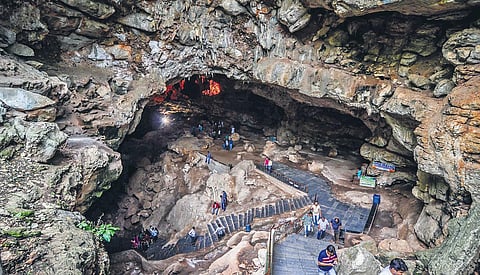

As you first glimpse the expansive valley, it reminds you of a big glistening emerald surrounded by mighty verdant hills. Verdant, but naked. But we digress. This well-kept secret in Andhra Pradesh’s northeast corner is slowly but surely becoming one of the region’s most popular tourist destinations and even though we’ve heard of it many times in the past — even once for alleged snowfall — it was world-renowned coffee that drew us here.
Araku or Aruku is a tale as old as time. It was always known, but required to be discovered. The British, like always, claimed to have discovered the valley before predictably then looting it of its natural wealth for over a century. Tale as old as time, indeed! The valley was, however, always considered a midland, both geographically and culturally. This home, to a largely Adivasi population, precariously holds together tribal hinterlands in both Andhra Pradesh and Odisha. So much so, most people here can speak both the languages (or at least local dialects of it) and treat the state border as simply as they would the threshold of their humble homes. Travelling across the border to the weekly market on either side is a done thing and spoken of nonchalantly, like a picnic at the local park.
We were invited to visit this unique piece of forgotten history as a part of the Gems of Araku festival that took place on May 4 and 5, earlier this year. The region, now globally renowned as a speciality coffee producer, is a favourite among coffee aficionados and cuppers (tasters/connoisseurs) — who consistently rate the coffees produced on the slopes of this 910-metre high valley, as some of the best in the world!
It should therefore be no surprise that we agreed to visit during this annual festival, just ahead of the monsoons. Gems of Araku began in the year 2009 and is curated by the Naandi Foundation and aims at celebrating the seasons’ speciality coffees as well as the farms and farmers in the Araku region. Over 1,200 coffees each season are put through a rigorous evaluation by professional cuppers following Specialty Coffee Association’s (SCA) cupping protocols and over 3,00,000 Adivasis from 35 major tribes, 90,000 farms and 1,500+ villages participate.
The scale is immense and the produce is the finest we’ve had the honour of ever tasting. The monsoons rolled into the valley the moment we arrived and the emerald green bowl looked fresh and inviting, now glistening with raindrops after a summer shower. As we indulged in freshly brewed cups of the winning lots in this beautiful backdrop, we asked a local chieftain, why were the verdant hills so bare? His answer only reminded us how isolation always comes with a price.
“The British tore down every standing tree here for timber and shipped it to London and around the rest of their empire through the port in Visakhapatnam and I am sure our trees now adorn their palaces,” he tells us as he stares at the beautiful but horrific silhouettes of the remnant naked hills against a poignant setting sun. That thought stayed with us as we ate dinner and retired for the night at the APTDC’s (Andhra Pradesh Tourism Development Corporation) Haritha Mayuri Hill Resort — one of the only two resorts in Araku, both owned by the government.
The next day was packed with visits to coffee estates, several Adivasi hamlets and a guided tour through the whole coffee-making process from crop to cup, courtesy Araku — a Paris and Bengaluru-based, terroir-mapped coffee brand that champions the Arabica coffee grown in the region and now markets it at great prices worldwide.
Following co-operative practices and organic farming methods, the Araku format of growing coffee not only makes for a great example that can be followed across the country’s coffee-growing regions, it also proved that disenfranchised tribal communities can successfully be brought into economic rejuvenation projects (that also mutually benefit them) successfully removing the multiple drawbacks of farmer-middlemen-seller models. The work done by Naandi Foundation has ensured livelihoods, education and employment have all taken turns for the better, and the enthusiastic participation of the farmers from across the region only proves this model works.
We then did the customary visit to the Tribal Museum (right next to the resort), and the Padmapuram Gardens (a short walk away), and also made plans for the nearby Borra Caves and Katiki Waterfalls for the next day. What really stayed with us, however, was the one-on-one interactions with the Adivasi farmers, who today, take so much pride in being the new protectors of their once-ravaged, now-reviving homeland.